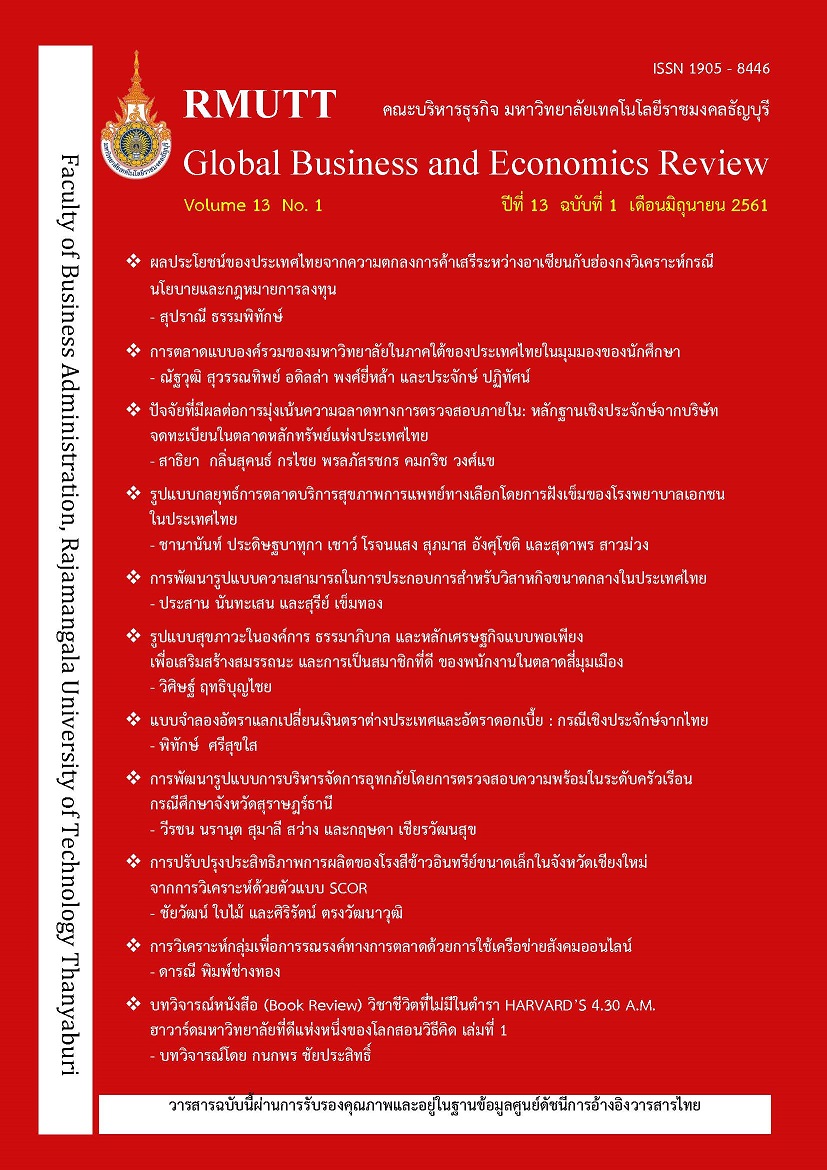PRODUCTIVITY IMPROVEMENT FOR SMALL ORGANIC RICE MILLS IN CHIANG MAI PROVINCE USING SCOR MODEL
Keywords:
SCOR Model, Small Organic Rice Mills, Economic Order QuantityAbstract
The objective of this research was to improve the efficiency of organic rice mills production in Chiang Mai Province. Although there are different methods in analyzing supply chain, this research uses Supply Chain Operations Reference (SCOR) model since it is a contemporary technique that is suitable for modern production management. The model has also globally been applied in various industries. However, a review of literatures found only qualitative studies using SCOR model in the rice mill industry. This study filled this research gap by applying mixed method methodology along with the SCOR model. We did a qualitative field study with an in-depth interview in the first stage, and then applied a quantitative approach by collection empirical data in the second phase of the study. The results showed that in the short-run organic rice mills’ supply chain can be improved by applying Economic Order Quantity in order to minimize inventory in the production line. In the long-run, however, other issues such as layout production and quality control might be taken into consideration.
References
กิรณา แก้วสุ่น และไกรชิต สุตะเมือง. (2559). อิทธิพลของการจัดการความสัมพันธ์กับผู้จัดหาวัตถุดิบที่มีต่อผลการดำเนินการด้านการจัดซื้อจัดหาผักและผลไม้สดในร้านค้าปลีกสมัยใหม่ในประเทศไทย. RMUTT Global Business and Economics Review, 11(2), 11-22.
เตชธรรม สังข์คร. (2560). ห่วงโซ่อุปทานเครื่องแกงของกลุ่มวิสาหกิจชุมชนในจังหวัดสุราษฎร์ธานี. RMUTT Global Business and Economics Review, 12(1), 76-88.
ไทยรัฐ. (2561, 17 มีนาคม). “ชุติมา” ชี้ทั่วโลกตื่นตัวใช้สินค้าอินทรีย์. ไทยรัฐ, น. 8.
ธันยธร ติณภพ. (2559). การจัดการห่วงโซ่อุปทานโดยวิสาหกิจชุมชนผลิตข้าวอินทรีย์ในเขตภาคกลางของประเทศไทย. วารสารวิจัยและพัฒนาวไลยอลงกรณ์ สาขามนุษยศาสตร์และสังคมศาสตร์, 11(3), 317-330.
บุณฑรี จันทร์กลับ และชลินธร ธานีรัตน์. (2558). การวิเคราะห์โซ่อุปทานของดอกมะลิ: กรณีศึกษาตำบลท่าเรือ อำเภอเมือง จังหวัดนครศรีธรรมราช. วารสารการวิจัยเพื่อพัฒนาชุมชน, 8(1), 94-107.
ปราโมทย์ ยอดแก้ว. (2560). การพัฒนาการตลาดข้าวอินทรีย์ในสังคมไทย. วารสารสันติศึกษาปริทรรศน์, 5(1), 406-420.
ผดุงศักดิ์ วานิชชัง, ใจทิพย์ วานิชชัง และสมควร มณี พิทักษ์สันติ. (2557). การปรับปรุงผลิตภาพการ ด าเนินงานโรงสีข้าวสหกรณ์. ใน การประชุมสัมมนาทางวิชาการ มทร. ตะวันออก วันที่ 14-16 พฤษภาคม 2557. ชลบุรี: มหาวิทยาลัยเทคโนโลยีราชมงคลตะวันออก.
ศศิวิมล สัจจิพานนท์. (2557). ข้าว. สืบค้นจาก http://www.ditp.go.th/contents_attach/82114/82114.doc
ศิวิไลซ์ กาญจนรัตน์. (2557). การปรับปรุงการจัดการโซ่อุปทาน: กรณีศึกษาผู้ผลิตมะพร้าวน้ำหอม. (วิทยานิพนธ์ปริญญามหาบัณฑิต, มหาวิทยาลัยเกษตรศาสตร์).
สมาคมผู้ส่งออกข้าวไทย. (2560). ผลผลิตข้าว. สืบค้นจาก http://www.thairiceexporters.or.th/production.htm
สำนักงานคณะกรรมการพัฒนาการเศรษฐกิจและสังคมแห่งชาติ. (2559). แผนพัฒนาเศรษฐกิจและสังคม แห่งชาติฉบับที่ 12. สืบค้นจาก http://www.nesdb.go.th/ewt_dl_link.php?nid=6422
สำนักงานเศรษฐกิจการเกษตร. (2559). การศึกษาผลกระทบของราคาส่งออกข้าวไทยและประเทศคู่แข่งที่มีต่อความต้องการนำเข้าข้าวจากไทย. เอกสารวิจัยเศรษฐกิจการเกษตร เลขที่ 128, กระทรวง เกษตรและสหกรณ์.
อดิศักดิ์ ธีรานุพัฒนา และจอน ตั้ง. (2552). การพัฒนาแบบจำลองการวัดสมรรถนะโซ่อุปทาน โดยประยุกต์ใช้ วิธีการวัดของ Chan and Qi (ทฤษฎีฟัซซีเซต) กับกรอบการทำงาน SCOR. วารสารบริหารธุรกิจ, 32(121), 11-33.
อารีย์ นัยพินิจ, ภัทรพงษ์ เกริกสกุล และธงพล พรหมสาขา ณ สกลนคร. (2557). การปรับตัวภายใต้กระแสโลกาภิวัตน์. วารสารวิชาการมหาวิทยาลัยราชภัฏสงขลา, 7(1), 1-12.
อโณทัย งามวิชัยกิจ. (2558). การวิจัยแบบผสมผสานเชิงคุณภาพและเชิงปริมาณ. วารสารการจัดการ สมัยใหม่, 13(1), 1-12.
Chaffey, D. (2007). E-business and E-commerce management: Strategy, implementation and practice. Essex, England: Financial Times Prentice Hall.
Creswell, J. W., & Plano Clark, V. L. (2017). Designing and conducting mixed methods research. Thousand Oaks, CA: Sage publications.
Felix T. S. Chan, & Qi, H. J. (2003). An innovative performance measurement method for supply chain management. Supply Chain Management: An International Journal, 8(3), 209-223.
Ghafour, K. M., & Rashid, R. H. (2016). Optimizing Multi-Item EOQ when the Constraint of Annual Number of Orders is Active. Modern Applied Science, 11(1), 55.
Handfield, R. B., & Nichols, E. L. (2002). Supply chain redesign: Transforming supply chains into integrated value systems. Upper Saddle River, NJ: FT Press.
Heizer, J., & Render, B., & Munson, C. (2017). Operations management: Sustainability and supply chain management (12th ed). Essex: Pearson Education.
Hsu, J. T., & Hsu, L. F. (2013). An EOQ model with imperfect quality items, inspection errors, shortage backordering, and sales returns. International Journal of Production Economics, 143(1), 162-170.
Khan, M., Jaber, M. Y., & Bonney, M. (2011). An economic order quantity (EOQ) for items with imperfect quality and inspection errors. International Journal of Production Economics, 133(1), 113-118.
Lin, T. Y., & Chen, M. T. (2011). An economic order quantity model with screening errors, returned cost, and shortages under quantity discounts. African Journal of Business Management, 5(4), 1129.
Mahanaseth, I., & Tauer, L. W. (2014). Thailand’s market power in its rice export markets. Journal of agricultural & food industrial organization, 12(1), 109-120.
Porter, M. E. (1985). The value chain and competitive advantage. New York: Free Press.
Robson, K. (2015). Create a customer centric culture and gain competitive advantage. Wiley Online Library. Retrieved form http://onlinelibrary.wiley.com/doi/10.1002/9781119208358.ch5/summary
Supply Chain Council. (2017). Supply Chain Operation Reference Model: SCOR Version 12.0. Pittsburgh, PA: Supply Chain Council.
Downloads
Published
How to Cite
Issue
Section
License
บทความที่ได้รับการตีพิมพ์เป็นลิขสิทธิ์ของผู้นิพนธ์
ข้อความที่ปรากฏในบทความแต่ละเรื่องในวารสารวิชาการเล่มนี้เป็นความคิดเห็นส่วนตัวของผู้เขียนแต่ละท่านไม่เกี่ยวข้องกับมหาวิทยาลัยเทคโนโลยีราชมงคลธัญบุรี และคณาจารย์ท่านอื่นๆในมหาวิทยาลัยฯ แต่อย่างใด ความรับผิดชอบองค์ประกอบทั้งหมดของบทความแต่ละเรื่องเป็นของผู้เขียนแต่ละท่าน หากมีความผิดพลาดใดๆ ผู้เขียนแต่ละท่านจะรับผิดชอบบทความของตนเองแต่ผู้เดียว







